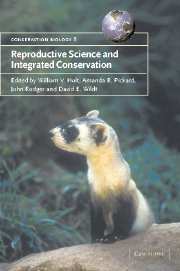Book contents
- Frontmatter
- Contents
- List of contributors
- Foreword
- Part I Introduction
- Part II Reproduction and population viability
- Part III Reproductive techniques for conservation management
- Part IV Integrated conservation management
- 14 Integrating reproductive sciences into recovery programmes for declining and extinct marsupial populations
- 15 Captive breeding and predator control: a successful strategy for conservation in Western Australia
- 16 Black-footed ferret: model for assisted reproductive technologies contributing to in situ conservation
- 17 Genetic resource banks for species conservation
- 18 Fertility control for wildlife
- 19 Contraceptive vaccine development
- 20 Field applications of fertility control for wildlife management
- Part V Reproduction science in non-mammalian species
- Part VI Conclusions
- Index
- References
19 - Contraceptive vaccine development
Published online by Cambridge University Press: 21 January 2010
- Frontmatter
- Contents
- List of contributors
- Foreword
- Part I Introduction
- Part II Reproduction and population viability
- Part III Reproductive techniques for conservation management
- Part IV Integrated conservation management
- 14 Integrating reproductive sciences into recovery programmes for declining and extinct marsupial populations
- 15 Captive breeding and predator control: a successful strategy for conservation in Western Australia
- 16 Black-footed ferret: model for assisted reproductive technologies contributing to in situ conservation
- 17 Genetic resource banks for species conservation
- 18 Fertility control for wildlife
- 19 Contraceptive vaccine development
- 20 Field applications of fertility control for wildlife management
- Part V Reproduction science in non-mammalian species
- Part VI Conclusions
- Index
- References
Summary
INTRODUCTION AND OBJECTIVES
Public acceptability of conventional strategies for the management of over-abundant wild animal populations (e.g. shooting, trapping, poisoning) is continuing to decline, particularly as they are not sustainable in the long term, especially for large, free-ranging populations. Significant interest is being shown in an ecologically-based approach to management of pest populations which recognises that a thorough understanding of the biology and ecology of the species is essential before integrated management of the species can be implemented (Singleton et al., 1999).
This chapter, which should be read in conjunction with Rodger's commentary (Rodger, Chapter 18) focuses on the development of contraceptive vaccines that are highly effective, long-lasting and that can be delivered to large, free-ranging populations in an environmentally safe and publicly acceptable manner. Progress will be reviewed for (1) the identification of appropriate contraceptive targets, (2) the strategies employed to increase the magnitude and longevity of the immune response to specifically target the reproductive tract and ensure species specificity and (3) the delivery of the vaccine via both disseminating and non-disseminating systems. We also address some of the issues relating to public acceptance of some of the proposed methods for delivery of fertility control and future priorities for research.
STATE OF THE ART
Contraceptive targets
A long-term contraceptive effect has been achieved in several animal species following immunisation with reproductive hormones (Cowan et al., Chapter 20).
- Type
- Chapter
- Information
- Reproductive Science and Integrated Conservation , pp. 291 - 304Publisher: Cambridge University PressPrint publication year: 2002



